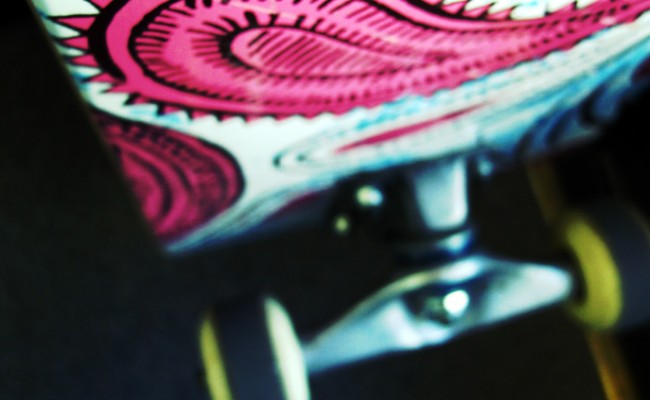How many more stories about Muslim women’s ‘empowerment’ need to be told until she’s empowered enough? Until she’s ‘normal’ enough? Until she’s ‘just like us’ enough?
The latest is a 30-minute VR short film called Storm Riders by London-based Australian contemporary artist Shaun Gladwell[1], showing at ACMI in Melbourne from 9 June. Described as an ‘immersive, intimate exploration of Islam, skateboarding and sexual politics’, the film follows the ‘surprising’ phenomenon of Muslim women skateboarders. Its aim: to tackle the stereotype of ‘passive, subservient Muslim women’.
Purporting a similar aim is the ABC mini-series Hijabistas!, which aired last month on iView. Hosted by (self-exiled) Yassmin Abdel-Magied, the series presents yet another ‘insider’ account on Muslim women ‘breaking stereotypes and inspiring others’ in the fashion industry, strangely predicated on the fact that the ‘Muslim modest fashion dollar’ amounts to $484 billion a year. These are just a couple of the myriad mediative representations of late that feature ‘the Muslim woman’ in a specifically ‘empowering’ narrative – one that presupposes a certain binate temporality of oppression to liberation, perverse to normal, backwardness to modernity.
As a Muslim woman myself, my frustration with these kinds of films occurs on two accounts: 1) that they necessarily invoke and rely upon the spectre of the mute, burqa-clad figure of ‘the Muslim woman’ for their legitimacy as ‘empowerment’ narratives; and 2) that they perpetrate a ‘positive exploitation’ of the bodies of Muslim women that necessarily panders to a neoliberal project of self-making.
Focusing on the latter account (because there are already so many excellent critiques of the first: see Lila Abu-Lughod and Nadia Fadil, for instance), I want to ask why the promise of ‘equality’, ‘freedom’ and ‘inclusion’ centres the experience of Muslim women who are seen to be ‘productive’, ‘triumphant’ and therefore ‘empowered’, rather than the systems of marginalisation and discrimination that make us have to ‘triumph’ and be exceptional in the first place? Put simply, why can’t our ‘equality’ be incumbent on our ability to just be?
In asking this question, I realise that so many young Muslim women sincerely believe in the ‘power’ of these representations – simply because we didn’t have these – or any – kinds of representations growing up where we could see our own selves reflected back to us in health and beauty ads, screen media and music videos. And I get that. Often times, because we couldn’t identify with the representations of hyper-feminised white bodies that saturated our understanding of what it meant to be a ‘woman’, ‘successful’ and ‘beautiful’, we learned not to care for and love our bodies. Our non-white, veiled, disabled, mis-gendered, racialised bodies. Or we didn’t know how.
In Technologies of Gender (1987), Teresa de Lauretis describes ‘the power of discourses to ‘do violence’ to people, a violence which is material and physical, although produced by abstract and scientific discourses as well as the discourses of the mass media’. For Muslim women, this violence is compounded by the overdetermined figuring of ‘the Muslim woman’ as an inherently subjugated and sexually repressed object dispossessed of all agency, which has become so pervasive and intrinsic to the cultural project of the War on Terror.
But what gets lost in our own traumas and our concomitant desperate efforts to heal from this trauma – for ourselves and for the generations of Muslim women to come – is the racialised power relations of representation which we take as our primary mode of healing. We forget that this discourse on representation is not a new one. As much as we want to believe that these celebratory and empowering representations of ‘girls like us’ are for us – because we are the ones we have been waiting for! – bell hooks teaches us that, as long as they are commodified, they are commodities, and commodities, irrespective of their subject matter or intended viewer, ‘are made, produced, and marketed to entice any and all consumers’.
What is common, then, to Farhana and Chadnee (who star in Gladwell’s film), Yassmin and even Amani Al-Khatahtbeh and Ilhan Omar in the US (who featured in Maroon 5’s recent music video ‘Girls Like You’), is that they represent the ideal ‘Muslim woman’ as a self-enterprising and desiring subject.[2] Obliged to mobilise her talents, social skills and (too) often her ‘exotic capital’ to navigate the ever-shifting network of goods, relationships, knowledge and institutions, whilst simultaneously engaging in a ‘desiring project’ that operates through normative sexual, material and affective self-interest, it is precisely (and only) this subject – self-enterprising and desiring – that neoliberal society rewards and folds into itself.
Of course, this logic also only rewards a certain kind of body: the cis-gendered, able-bodied kind. Cultural anthropologist Lisa Hoffman (2003) argues that this is how the space of ‘freedom’ gets transmuted into the field of neoliberal governmentality. For the Muslim woman who features in specifically ‘empowering’ narratives to the likes of Gladwell’s Storm Riders, her designation as ‘empowered’ and therefore ‘free’, ‘equal’ and ‘included’ (with the rest of ‘us’) is predicated upon her capacity to be exceptionally self-enterprising and prodigiously desiring.
But this only stabilises the white neoliberal and patriarchal status quo.
Although these representations offer multidimensional images of Muslim female life, the fact that they are always refracted by the white/neoliberal gaze – for Amani and Ilhan, it is Adam Levine (a white, cis-hetero man) who speaks for them; Farhana and Chadnee only begin to see themselves as ‘empowered’ through the camera lens of another paternalistic white cis-hetero man; and for Yassmin, well, the ‘Muslim dollar’ goes a long way to securing representation – that confines them to a conventional stereotypical framework that continues to exoticise and infantilise (read: orientalise) ‘the Muslim woman’. They become the living, breathing embodiment of the pitfalls of neoliberalism: that you only matter insomuch as you can be used as a symbol to justify the status quo. Gaslit by the appeals to neoliberal subjectivity in a pervasive commodity culture, they are only actually ‘equal’ to participate in the imperial project of neoliberal capitalism.
I want to be clear here in saying that I’m not asking, nor am I interested in, why these individual women ‘choose’ to insert themselves into such narratives. I find this question irrelevant, because its asking only further perpetuates the labour-intensive project of confession that marginalised and racialised bodies are always already subject to. And, it basically misses the point.
Instead, my aim here is to urge the more productive and long-overdue project of interrogating and indicting the systems, structures, institutions and corporations that profit from her body that is only ever interpellated – and given the proverbial ‘seat at the table’ – through a neoliberal ‘way of doing things’. Celebrating her ‘empowerment’ only stabilises the racial logics of neoliberal governmentality through which individuals are made to ‘overcome’ in order to be conferred a subject status. And in so doing, it crucially de-responsibilises organisations, collectives, institutions from having to do better to create a better world in which human beings are truly born equal to live freely in whichever way they choose to, quite simply, ‘be’.
So no, we don’t need more representations of Muslim women’s ‘empowerment’ mediated through the white/neoliberal gaze. What we need is to DIS-EMPOWER the racist systems and structures of neoliberal governmentality that prioritise and maintain the superiority of white and Western cosmologies of being at the expense (sometimes quite literally) of all other bodies. Structures that perpetually insist on our dehumanisation and relegation to the peripheries. Operating within this system, there is nothing revolutionary about white men saving brown women – after all, that is the history of colonisation and empire. We don’t need more saviours; we need more of you to recognise that your subjectivity as ‘free’ and ‘equal’ beings is actually incumbent on our own. As a starting point, step aside and make a real space for us to create, represent and be visible on our own terms.
Notes
[1] Some of Gladwell’s previous works include 1000 Horses which, commissioned by the Tel Aviv Museum of Art with the aim to connect ‘Israeli history to the history of Australia’, references The Battle of Beersheba (31 Oct 1917) that resulted in the British colonisation of Palestine. Commissioned by the Australian War Memorial’s ‘official war art scheme’, Gladwell also travelled with the Australian Defence Force (ADF) to Afghanistan in 2009 to produce artistic representations of soldiers’ experiences, of which the outcome was his VR film Shaun Gladwell: Afghanistan. Based on this history, I am finding it difficult to separate his new film from his other works that engage projects of occupation, colonisation and the white saviour complex.
[2] I borrow this idea of the self-enterprising and desiring subject from Travis SK Kong’s 2012 work on neoliberal subjectivities in post-socialist China.
Image: Russ Morris / flickr






